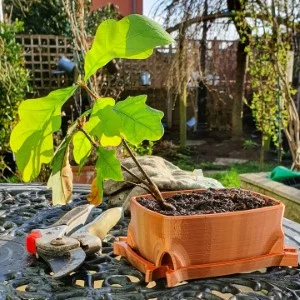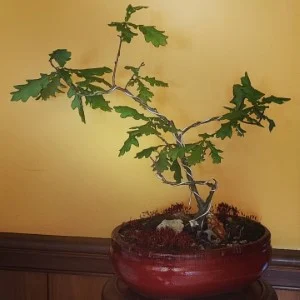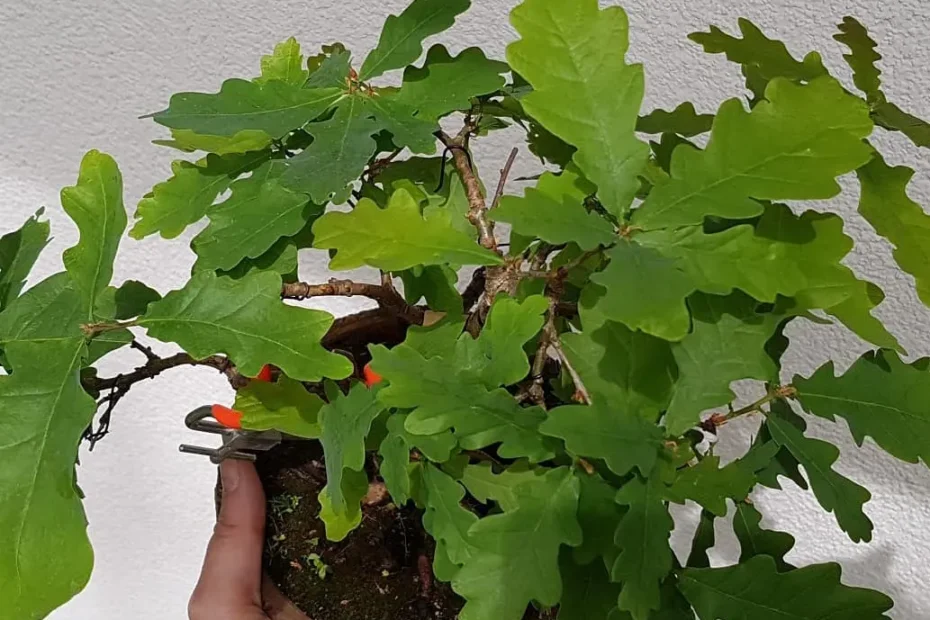Introduction
Bonsai, an art form of Japanese origin, has long celebrated the miniature portrayal of nature in pots. This craft, evolving over a millennium, reveres the oak for its enduring presence in the pantheon of bonsai specimens. Oak trees, with their impressive longevity and robust stature, symbolize strength and resilience, characteristics highly esteemed in the bonsai tradition. Cultivating an oak bonsai is a testament to the grower’s dedication and a reflection of nature’s persistent force.
Unveiling the Bonsai Oak Tree
Choosing Your Oak Bonsai
Selecting the right oak species for bonsai cultivation is a pivotal decision that influences the care and the eventual aesthetics of your miniature oak tree. Among the myriad of species, the English Oak (Quercus robur) and the Cork Oak (Quercus suber) stand out as prime candidates for bonsai due to their distinctive characteristics and adaptability.
English Oak is celebrated for its classic, deeply lobed leaves and a rugged, gnarled appearance that lends itself perfectly to bonsai cultivation. For beginners, this species is advantageous due to its robustness and relative ease of care. However, its vigorous growth rate necessitates frequent pruning to maintain a miniature size, a task that may be more suited to those with some experience in bonsai care.
Cork Oak, on the other hand, intrigues enthusiasts with its thick, corky bark and smaller leaves, which naturally complement the bonsai form. This species tends to be more forgiving with watering mishaps, making it a suitable choice for beginners. However, achieving the distinctive cork-like bark in miniature form can be a lengthy process, presenting an exciting challenge for more experienced bonsai artists.
When acquiring your oak bonsai, there are two paths: selecting a healthy pre-bonsai or starting from scratch by germinating your own acorn. For beginners, acquiring a pre-bonsai can offer a more immediate start to the bonsai experience, allowing for focus on shaping and care techniques. If you opt for germination, select acorns in early autumn, ensuring they are free from damage or disease, for a more personal and rewarding bonsai journey.
Location
The ideal location for an oak bonsai extends beyond simply placing it in full sun. Proper air circulation is crucial for preventing diseases, while afternoon shade in hotter climates can protect the tree from excessive heat stress. Additionally, understanding the oak’s winter dormancy needs is essential; most oak bonsai require a period of cold dormancy to thrive. Positioning your bonsai to meet these requirements ensures not just survival, but a flourishing miniature ecosystem.
The Art of Watering
Watering an oak bonsai is an art form that demands attentiveness to the tree’s unique needs, which can vary by soil type, season, and the condition of the foliage. Instead of adhering to a rigid schedule, learn to recognize the signs of thirst in your bonsai. Soil should be observed closely; it must dry out moderately between watering sessions. During active growth periods in spring and early summer, your oak may require more frequent watering, while in winter, less. Adaptability and observation are key to mastering the art of watering.
Unlocking Bonsai Soil Secrets
The foundation of a thriving bonsai lies in the soil. A well-draining bonsai mix is non-negotiable, as it prevents waterlogging, ensuring that roots remain healthy and aerated. For enthusiasts looking to mix their own, components like Akadama, pumice, lava rock, and finely ground bark create an ideal blend that supports root growth while ensuring proper drainage.
Alternatively, high-quality pre-mixed bonsai soils are available for those seeking convenience without compromising on the health of their miniature oak. Understanding and utilizing the right soil mix plays a crucial role in unlocking the full potential of your bonsai oak tree.
Bonsai Oak Tree Cultivating Your Miniature Masterpiece
Root Care: The Foundation of Strength
Proper repotting is a linchpin in the cultivation of a healthy and resilient oak bonsai. The roots, being the foundation of strength for your bonsai, require careful management to ensure the tree’s overall wellbeing. Repotting is best timed in early spring, just before the onset of the growing season, to minimize stress and allow the tree to recover during its peak period of growth.
The process involves gently removing the bonsai from its pot, pruning away any dead or overly long roots to encourage a denser root system, and then replanting in fresh, well-draining bonsai soil. This careful pruning stimulates healthier root growth, which is crucial for maintaining the miniature stature of the bonsai while ensuring it has the vigor to thrive. Remember, the goal is to balance the root mass with the foliage, creating a symbiosis that reflects the majesty of nature in miniature.


The Bonsai Pruning Philosophy
Pruning goes beyond mere cutting; it is an art that shapes the very essence of a bonsai, imbuing it with character and form. For oak bonsai, techniques like pinching back new growth, careful defoliation (to be undertaken with caution due to oaks’ sensitivity), and strategic branch bending are employed to encourage a desirable shape and foliage density.
Before-and-after photos of bonsai specimens showcase the transformational power of these techniques, accentuating the value of patience and vision in bonsai cultivation. Pinching is used to control new growth and maintain the tree’s form, while defoliation can stimulate leaf reduction and increased ramification but requires a knowledgeable hand to avoid stressing the tree. Branch bending, achieved through careful wiring or ties, allows for the reshaping of the tree’s silhouette according to the grower’s vision, albeit with a gentle approach given the oak’s sensitive bark.
Wiring Techniques and Alternatives
Wiring is a common technique for manipulating the shape and direction of bonsai branches, but it comes with challenges when applied to oak trees, whose bark can be particularly vulnerable to damage. Beginners might find success with alternative methods such as using soft ties or string to encourage branch positioning, offering a gentler approach while still achieving significant aesthetic changes.
These methods require patience and a gentle touch, as the aim is to guide the tree’s growth without causing harm or unnecessary stress. Over time, these techniques allow for remarkable transformations, with the added benefit of being more forgiving for those still refining their bonsai crafting skills.
Maintaining Balance Bonsai Oak Tree
Common Oak Bonsai Maladies
In the tranquil world of oak bonsai cultivation, vigilance against disease is paramount. Powdery Mildew and Leaf Spot Diseases are notably common foes, manifesting as white, powdery coatings or dark, blemished spots on leaves, respectively. These afflictions not only mar the aesthetic appeal but can weaken your miniature oak over time.
Organic solutions like neem oil or a mixture of baking soda and water can effectively combat these diseases; applying these treatments early in the morning allows the foliage to dry thoroughly, reducing further risk. Preventative measures include ensuring good air circulation around your bonsai and avoiding overhead watering to keep the leaves dry.
Uninvited Guests: Pest Patrol
Even the most dedicated bonsai caretaker may encounter pests, with Scale, Aphids, and Spider Mites being the most common culprits. These pests drain the vitality of your oak bonsai, leading to discolored leaves, stunted growth, and in severe cases, the demise of your miniature masterpiece.
Organic control methods offer a safe and effective defense; neem oil, for example, is a natural pesticide that disrupts the life cycle of pests without harming the bonsai. Introducing beneficial insects, like ladybugs, can also naturally control aphid populations. Regular inspection of your bonsai for early signs of infestation is a crucial preventative step, ensuring these unwelcome guests don’t settle.
Diagnosis and Revival: Troubleshooting Common Bonsai Oak Issues
A healthy oak bonsai is a balance of proper watering, lighting, and care, yet issues like underwatering, overwatering, and lack of growth can still arise. Underwatering leaves the bonsai parched and wilted, demanding prompt and thorough watering until moisture runs freely from the drainage holes. For overwatered oaks, which exhibit yellowing leaves and a spongy trunk, allowing the soil to dry and improving drainage can reboot health.
Lack of growth, often a puzzle, might signal inadequate light or nutrient deficiencies; ensuring your bonsai receives ample indirect light and fertilizing during the growing season can reignite growth. Recognizing and remedying these issues promptly can restore and even enhance the vigor and beauty of your bonsai oak, establishing a thriving bond between you and your miniature natural world.
Bonsai Oak Tree the Journey Continues
Fertilizing for a Thriving Bonsai Oak
A thriving bonsai oak requires more than just water and sunlight; it demands the right balance of nutrients, particularly during its active growth periods. Utilizing a balanced, slow-release fertilizer rich in nitrogen, phosphorous, and potassium is essential to support the tree’s foliage and root development. During the growing season, from spring to early fall, fertilizing every four to six weeks will keep your bonsai vigorous.
However, as winter approaches, it’s important to taper off fertilization to prepare the tree for dormancy. Overwinter, bonsai oaks appreciate a rest period with minimal to no fertilization, aligning with their natural growth cycle. This careful calibration of nourishment not only supports the health of your bonsai but also its aesthetic splendor.
Winterizing Your Oak Bonsai
Protecting your oak bonsai during winter is paramount to its survival and thriving in the successive year. Start by assessing your local climate; in regions where temperatures drop below freezing, consider moving your bonsai to a protected area like a cold frame or an unheated garage, ensuring it’s exposed to natural light and periodic checks. For those in milder climates, your bonsai can remain outdoors but requires some preparation.
Shield the pot, particularly if it’s ceramic, with bubble wrap or burlap to prevent cracking. Elevating the bonsai off the ground can also help avoid root rot from excessive moisture. Adjust watering schedules since your bonsai’s water needs will decrease significantly during dormancy. Remember, the goal is to mimic the oak’s natural environment as closely as possible, providing a period of rest without completely halting its life cycle.
The Bonsai Journey: A Never-Ending Dance
Cultivating an oak bonsai is a labor of love and patience, a testament to the caretaker’s dedication to nurturing a slice of nature’s majesty. Mature bonsai oaks stand as proud examples of what consistent care and mastery can achieve. These aged specimens, with their gnarled trunks and lush canopies, are a source of deep satisfaction and inspiration. They showcase the beauty of perseverance, evolving through the seasons and years, reflecting the life-long commitment of their growers.
As you continue your bonsai journey, remember that each trimming, each watering, and every moment of care brings you closer to mastering this ancient art form. There’s a profound sense of fulfillment in witnessing the gradual, yet dramatic, transformation of a simple oak sapling into a majestic bonsai, emblematic of both nature’s resilience and aesthetic grandeur. The pursuit of bonsai excellence is indeed a never-ending dance with nature, wherein each step brings its own rewards, challenges, and lessons.
Conclusion
Cultivating a bonsai oak rewards the patient gardener with a unique blend of art, nature, and discipline. This ancient practice transforms a seedling into a living sculpture, revealing the strength and beauty of nature in miniature. Each phase of care—be it pruning, feeding, or winterizing—deepens the bond between the gardener and their bonsai, creating a source of pride and a symbol of perseverance. The joy found in this meticulous art form is immeasurable, offering a serene escape and a gratifying challenge.
We’d love to hear about your bonsai oak journey or answer any questions you may have. Share your experiences or inquiries in the comments below and join our growing community of bonsai enthusiasts.
